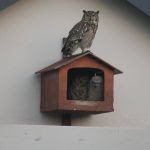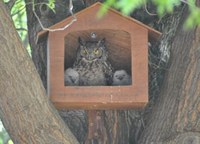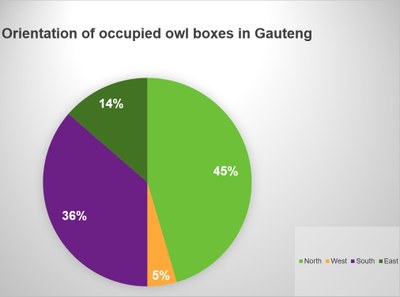Owl Box FAQ
Owl Box Occupancy
One of the most frequently asked questions that we receive from prospective and excited clients regarding their new owl box is “How long before we have owls?” 15 years along and this is still a question that we are unable to answer. What we can tell you is based on the 150 plus EcoSolutions owl boxes that are serviced and occupied nationally. We have experienced owls occupying owl boxes within two weeks from the installation date however, this is far from the norm. The large majority of our occupied owl boxes have taken anything from 2 - 5 years before occupancy occurs. That is the reality of it, you could be waiting for 5 years for occupancy to occur; that is if you experience occupancy at all.
The most important component in an owl box is not it's design, it's colour or even it's location. It is the substrate within the box. This substrate allows owls to form a ''cup'' in which to lay their eggs and raise their young. Without annual substrate replacement, the box is not an owl box - it will not be used by owls and is really just a box high up in your tree.
EcoSolutions has over 130 occupied owl boxes in Gauteng. All of these boxes are serviced annually in order to maintain owl occupancy.
View our interactive occupied owl box map below:
Owl Box Service
Why does my owl box need to be serviced annually and the substrate replaced? Owl boxes are designed to replicate a cavity in a tree. Although South Africa's urban centres are well treed, the majority of the trees are alive and unlike dead trees, do not have natural cavities. As a result, your owl box will attract the attention and fill the requirements for many cavity breeding and roosting residents. It is fine for squirrels, Egyptian geese, Genets and other birds to use it out of season. However, these usurpers bring sticks, paper, litter and all sorts of things into the box. Unless these are removed, owls will not utilise your owl box to breed in.
Once a year, prior to the owl breeding season, EcoSolutions undertakes to clean out the box and replace the substrate necessary for owl occupation. In addition, your annual service allows us to check that the box is still firmly attached, provide it with a new coat of varnish and make sure that the bee proofing is still intact. Additionally, the service component allows us to seamlessly introduce improved designs, greater expertise and understanding into our programme. If our data reveals that a specific orientation is optimum for successful occupancy, we will implement this during your annual service.
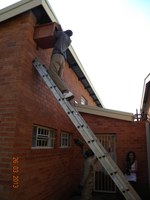
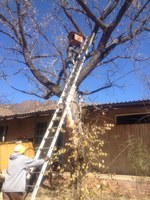
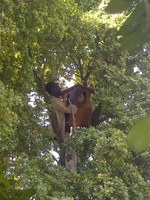

To turn your owl box into a viable owl breeding site, arrange service here.
Owl Box Orientation
The correct orientation of an owl box is always a topic for discussion. It has been said that the box must face south, north, east or west from an “authority” on the topic. Alongside is a graph indicating preference percentages for 80 occupied owl boxes. The graph indicates a strong North (45%) or South (36%) preference. West and East facing boxes appear to be less attractive to owls. We use the word ''appear'' because we are not sure if there aren't numerous variables and biases that contribute to this graph that has nothing to do with an orientation preference.
The majority of houses in the Southern Hemisphere are North facing in order to maximise winter sun and summer shade. When EcoSolutions install an owl box, we generally face the box towards the home of the client in order for them to see into and monitor the box for occupancy. As a result, these boxes would have a South orientation. In many gardens with North orientated homes, we often place the owl box in the more secluded “back” garden. This would result in the owl house having a North orientation. We very seldom place boxes with the entrance of the box facing away from the house i.e East or West. This may account for the lower occupancy percentage as indicated on the graph. As a consequence of this installation bias, it is almost impossible at this stage to categorically say that there is an orientation preference.
Establishing an orientation preference is still an ongoing undertaking and we are adding data relating to orientation on completion of each owl box service.
Owl Box Location
It would be fitting if our data showed a preference by owls for indigenous trees in which to breed. It doesn’t. Pine trees, Gum trees, Plane trees, Oak trees, Syringa trees etc. are all suitable for owl box installation. As are many indigenous trees. We have occupied owl boxes in trees, on gum poles and on buildings. The key to location is more about finding a place that is relatively undisturbed instead of a specific tree or site. Undisturbed is not necessarily a remote tree at the bottom of the garden - owls in urban areas are comfortable with cars, driveways, kids, dogs and cats. Undisturbed really covers direct disturbance. A place where people cannot easily access the box and remove chicks or bang against the box which would cause the owls to leave the box during the day. Disturbing an owl in a breeding box during the day is problematic. The female will often not return to the box until nightfall and consequently, the chicks are left unprotected from crows, cats and other potential predators of small chicks and eggs. In addition, the owlets and eggs, without the female to shield them can be exposed to long periods of sunlight or high winds or afternoon showers. If we have to disturb an owl, for ringing purposes for instance, it is always undertaken at dusk as this allows the female to return to the box quickly once the ringing has been completed.

